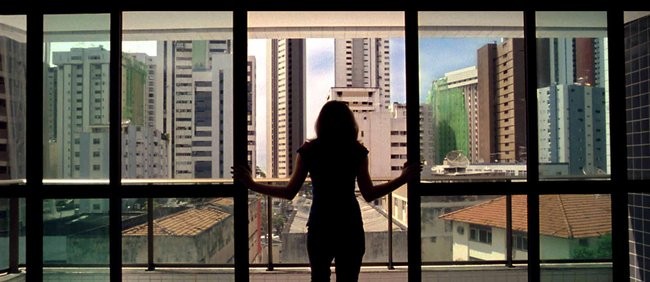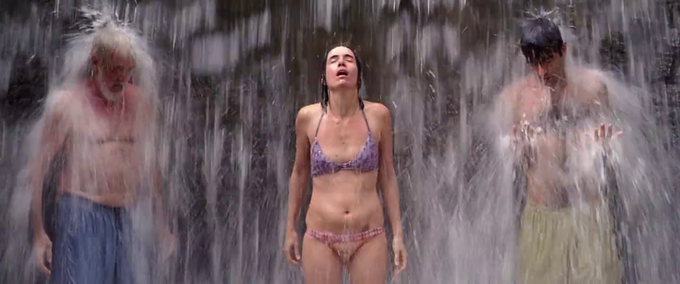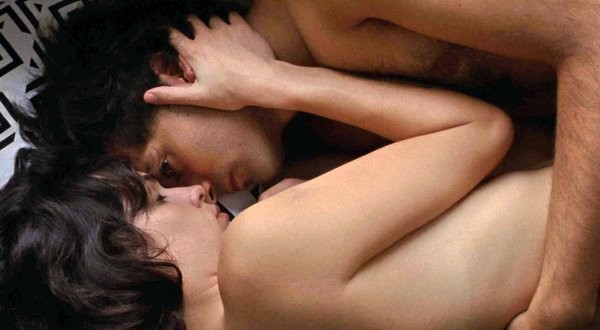Papa Vinyard here, now here's a little somethin' for ya...

Kleber Mendonca Filho's NEIGHBORING SOUNDS first appeared on the festival circuit in early 2012, and played in New York cinemas in August of that year. It made A.O. Scott's top 10 list that year, and has been available on Blu-ray since this past May.
However, due to the bizarre bylaws of the Academy of Motion Picture Arts and Sciences, the film is being submitted as Brazil's pick for Best Foreign Language Film for 2013. If the film is among the lucky 5 to be nominated this January (probably joining the likes of Asghar Farhadi's THE PAST, Wong Kar-Wai's THE GRANDMASTER, and maybe Haifaa Al-Mansour's WADJDA), it would be a well-deserved nod; the film is a wonderfully low-key drama, filled with the culture of everyday Brazilian life (basically the whole film takes place on a city block in the Brazilian state of Pernambuco), and often quite funny.
It's both cinematic and humdrum, humorous and sad, optimistic and cynical, but always thoroughly intimate and human. Just when you think you have a bearing on what kind of movie you are watching, events and revelations unfold that challenge your perception while elevating the work to something greater than a talky "slice-of-life" flick. It's a clever, confident feature debut by Mr. Filho, one that announces a filmmaker who has no problem taking his sweet time making his point, or even assuring you that there is a point to be made, while you're sitting there simply enjoying the narrative unfold.
Last month, I was lucky enough to meet with Filho, face-to-face, to discuss his film (over 2 years since it's production), what it meant to him, and how the subtleties of the film are actually indicative of a much more complicated, well-imagined vision than meets the eye. Keep your eyes peeled for references to John Carpenter, Joe Dante, and Pino Donaggio, and the oddball, indirect way they've influenced his work.

VINYARD: First off, I just wanted to let you talk a little bit. If you could just tell me…there was a lot to take in for me when I was watching the movie, so I just want to know what your process was. Just talk about your approach to the film initially, and we'll go from there.
KLEBER: I'd made a lot of short films, even beginning in the '90s, but in the '90s I did a lot of videos which were not really respected as films because they were video. And then with the digital revolution in the late '90s, that's when video became more respected and noble because of digital. I even remember in '98 at the Cannes film festival- I wasn't there, but there was this whole wave coming from Cannes with the two films from Dogme 95, Lars Von Trier and Thomas Vinterberg's films, which were shot on video, and that's when things changed I think, the whole technical revolution. And then in the last 10 years, before I made NEIGHBORING SOUNDS, I made 6 or 7 short films, and they were different formats. They were mini-DV, still photographs, and 35mm. And that's when my short films became more known and more successful, because the format thing kind of became the norm. So from 2002-2008, I made these very successful short films, and I should point out that they were very, very popular and very successful. They became something that I really enjoyed making, and I think naturally people began to wonder when I would make my first feature. And then one day, I sat down and wrote the script, and I wrote the script because there was a deadline coming up for the Ministry of Culture, and that's where some of the funds come from in Brazil. I wrote the first draft in seven or eight days, and I was very happy with the script, and began to show it to people. The following year, we got the rest of the funding from other sources.But the process of writing the script was very much like…I didn't have a masterplan. I had a number of situations which I found interesting in terms of tension and conflict, and a lot of these situations came from personal experiences I had had, or stories I had heard about. They were very mundane, and very kind of normal, the kind of thing that can happen in this parking lot (gestures out the window), or downstairs, or you know, in the lobby area. Things that happened to friends of mine, and things that I saw happening in the street where I live, which is, in fact, where I shot the film. And I think one thing that happened during the process was…you know when you're reading a book, and you want to go back home to keep reading the book? Friends ask you to have dinner, and you say "Ehh, yeah, well, I have stuff to do," but you actually want to back and read the book. And I felt like this when I was writing the script. I didn't really know where it was going, but I had these situations, and I began to picture the film. I mean, the situations were very and normal, but if I shot it like a movie movie, a kind of framing and style, I could probably- this was all theory,- but I could create some tension between the style and the content, because the content was so down to earth and kind of normal, stuff that happens. But a lot of it had to do with fear, with people fearing something, sometimes the dark, sometimes other people. I think that's very cinematic, a face in a close-up, it's a very cinematic image, and I began to- I also remembered the films I grew up with.
I was a young child in the '70s and i was a teenager in the '80s, so the films I grew up with were like John Landis, Joe Dante, Spielberg, John Carpenter. And a lot of their films take place in suburban environments, suburban neighborhoods, but a lot of those films, they go to the fantastique, I was always very attracted to that. AN AMERICAN WEREWOLF IN LONDON takes place in 1981 England, and everything is very realistic. You see the London Underground, you see a British house from the inside, and you see the streets, but it's a werewolf movie. That's something that I've always been attracted to, that idea, that tone, that style. John Carpenter's ASSAULT ON PRECINCT 13 and HALLOWEEN are great films, but they're very Los Angeles 1976, and Halloween is very much life in the neighborhood. You see the neighborhood, and the houses, and the street, and it's Panavision, but still, it's a suspense thriller, a horror. And I thought I should make an honest film, but try and frame it in a kind of fun, and what in my mind is a very movie movie cinematic style, which, for some reason, is kind of rare these days. So many people love the films from the '70s, but I don't really see these movies channeling this heritage into modern film. You look at new films, at modern films, and they look like they were made by some app! (I laugh)They're kind of professional, but they look like they come from this machine that makes films the way they're supposed to be made in 2013, and I wanted to avoid that.
VINYARD: Yeah, that's all they are, professional, they're not personal. Did you come at this as a- 'cause you said you got a lot of this from your own experiences in Brazil- did you come at it as an observer, or was there a lot of your own personal experiences in there? Did you personally connect with any of the characters more than the others?
KLEBER: That's an interesting question, because it almost points to the side of failure, because a lot of the situations are personal, or personal observations and themes. But I think ultimately, in the finished film, the whole thing comes off as slightly, or maybe very, detached, and maybe taking two steps back and looking at things. But I have to say that I was always- I respect each and every character in the film. I don't despise any of them, any one of those characters. I hope it doesn't come off as me looking down on them, like, "Hey, little people, down there!" It was really important not to judge those characters. For example, maybe in some other film or book, Mia, the housewife who has two kids, maybe some judgement would be passed on her sexuality, or her marijuana habits, but to me, she's great and yeah, she has a habit, so what? The patriarch, that's the tricky one, because he has a past of violence maybe, and power, but still a grandfather who seems to love his family. He's definitely not perfect, but I always find it interesting when a character confuses rather than gives you certainty about everything.It's tough for me to give an interview now, a year and a few months since the film has been doing the rounds, because if you'd interviewed me right when I'd finished the film, I was so full of questions about what I did, but now I have hindsight, and I can also tell you about the reaction that I've had with this film, the reaction that people have shown me about the characters. And it seems that I succeeded in not presenting this judgmental approach, like "I am superior, and you are wrong." That's not the way that people have reacted to the film. This makes me very, very happy, because I would be truly saddened and disappointed if that was the general perception, then I would have to learn, "Maybe I made a mistake." But I was really into looking at people in a very kind of free and understanding way, without judging.

VINYARD: You very quickly realize that the film isn't going to focus on one character, specifically, and that it is an ensemble film; I think maybe by the second or third scene, it becomes fairly obvious. But, like you said no one is superior. There are characters on both sides of the economic spectrum, but they both have something to lose, and they all have something to gain from the other side. The poorer characters are very excited about breaking into cars, breaking into the houses, taking merchandise, things like that, siphoning off what they can off of the more endowed people, and the wealthier people, of course, are insecure about losing that wealth, and are struggling to exert power over the area, So, there's definitely a sense that being wealthy, or being a higher class, doesn't necessarily buy you out, doesn't necessarily remove you from the troubles of that neighborhood. Is this- I'm not as well versed on the economic structure of Brazil- is this something that you wanted to tackle, the economic separation between these two classes and how it affected them?
KLEBER: Yes. It was mostly because…it's very hard for me to say this, but looking at the portfolio of Brazilian cinema, I always thought that most films didn't get that quite right. Sometimes, the filmmaker comes from an obviously high layer of society, and the way he or she portrays people from the lower layers of society's downright problematic, because he or she doesn't even know he or she is doing that, because it's so ingrained in their upbringing and social DNA, that they'll do something that…"Am I watching…did the maid just get portrayed the way she was portrayed in the scene I just saw? I thought that person knew better!" That kind of thing, and I thought that it's so much more complex- also, one of the things I discussed with the actors during the preparation, was that we would never use the word "racism" in this film. It should never become a topic of conversation, but it should always be there for you to see. I mean, "Jeez, look at this scene, no one's discussing racism!" And that's very much the way it happens in Brazil, because Brazil does not think of itself as a racist country. It is not, officially, a racist country.
VINYARD: I kind of think of this country similarly. Maybe not to that extent, but-
KLEBER: Yeah, it's different. It's really hard for me to explain this to an American, because you had the whole civil rights thing going on in the '60s, and you had the Ku Klux Klan, and Mississippi and Alabama-
VINYARD: Very pointed.
KLEBER: Very pointed, literally and metaphorically. There was real violence and hatred. There's nothing like that in Brazil. There's no hatred, like "Get the fuck out of here you N**GA, I hate you because you're disgusting."
VINYARD: It's unspoken.
KLEBER: It's unspoken, because since the abolition of slavery, not much has improved in the way that blacks are seen. They're still very much servants, so that creates a sort of racism by design. If you see a black man driving a BMW in Brazil, he's obviously a chauffeur, or a driver, he doesn't own that car. And then, turns out, the guy actually owns the car. "Oh, he owns the car, so he must be a football player, right?" (we laugh) And, in fact, he is a football player. That's the nasty reality of it. So racism is very peculiar in Brazil, extremely cordial and different from anywhere else. In France there are the tensions between the Arab population and the old, colonial French past. England has had, throughout the years, the whole thing with West Indians, Indians, and Pakistanis.Brazil is officially mixed, we are all everything; I probably have Brazilian-Indian blood, or some African blood, or Portuguese, and maybe Dutch somewhere along the line, and that's how Brazilians are. But ultimately, you end up with the design of racism. The way you look at society, unfortunately, you kind of understand how it's hard not to react as a racist in Brazil, in terms of the smallest decisions that you make every day and how you judge people. In that sense, the Joao character, the grandson of the family who has the new girlfriend? He's almost like a prince, because he's been to Germany, he has this foreign exposure, he's very liberal, but he's still awkward in some situations, especially with the family of his maid, and the way her family takes over his place. That's something that happened to me personally. We had a maid that worked for many years at our house, and sometimes I'd come back and her son would be sleeping on the couch, or her daughter would bring her children, my maid's grandchildren. Those kind of tensions I thought should be in the film, not spectacularly, but on a small scale.

VINYARD: All the moments of sublime happiness in the film- and there are a few, for a film you could call maybe more low-key and subtle- there are moments of pure ecstasy and elation with…the washing machine (which the "housewife" character uses to masturbate) is an example that comes to mind, and the couples sneaking off for little trysts here and there. But all these moments are stolen. They're not inherently provided by their environment. They're little fractions of moments that the characters have to find for themselves.
KLEBER: I agree. It's almost like little feats of small-scale anarchy. (I laugh) Like the washing machine, you're not supposed to use it like that. The couple that goes off into the house which is empty, you're not supposed to do that, but you can.
VINYARD: They have a big bed! (A justification the characters use for their sex-fueled B & E)
KLEBER: Yeah, right.
VINYARD: Was it always your decision, from the script stage, to keep the music- I'd say 90% of the audio is production audio. There's no non-diagetic music. Is that something you always planned on? Because it seems like a perfect fit for the content.
KLEBER: It was something that was decided at script stage, but I never decide something, as a rule, I have to let the film tell me if that works, because sometimes you have an idea, and you try the idea, and the film tells you, "I don't want that!" So you have to respect the film. It's like the length of the film. I used to tell my friends who made the film with me, "Whatever's best for the film. If it wants to be 88 minutes, it's going to be great at 88 minutes. If it's- I really hope not, but if it wants to be 3 hours, it's going to be 3 hours. It turned out to be 2 hours and 10 minutes, which is still long, but it is what the film wanted to be. The use of music, I thought that if I didn't use a proper classical soundtrack, you would be more compelled to watch what was going on, because it seems to generate tension in audiences who have been force-fed music all the time in commercial cinema, or even other kinds of films. I think music has become a kind of crutch for telling stories.Actually, I sound like a hypocrite when I say this, because a lot of the sound construction of the film does exactly that; sometimes it suggest things that you should feel, but in a very- what I think is a subtle way. It's not like- I mean, I love great classic scores like everybody else. Morricone, and even John Williams has some amazing…Pino Donaggio is fantastic. But if I did that with sound effects, and ambience, and strange sounds which maybe wouldn't be there in another film, I would have the effect of music, but without actually using music. So that was something that I wanted to do in the film. And then, of course, the opening track is the standard use of music in a film, but all the other music cues happen inside the scene, and that's very kind of attractive.

VINYARD: The film has a structure- I guess this is my last question. There's an intro with the black and white shots, there's some random shots of kids playing, and the one couple is making out, and then it goes into the titles, Part 1, Part 2- I believe there's three parts. Two part question: one, why did you choose to separate it like that, because at first I thought you were going for a timeframe separation, because Part 1 is the day, Part 2 is at night, but then Part 3 kind of bleeds into the rest of the next day. So I was wondering how that structure came together, and part two of the question: could you talk a little bit about the introduction, because the introduction is maybe the most abstract part of the entire film.
KLEBER: But not so abstract once you reach the end of the film, maybe.
VINYARD: Could you talk a little bit about what the intro meant to you?
KLEBER: The three parts…it was not in the script, it came in the editing stage. I just felt…(pauses) I just felt like it needed- I see those three parts as almost like a special effect, because it helps you- it's like when you're writing, and you decide that there's a new paragraph. You can do that, maybe in other ways, with a film, maybe with a black screen or something, but I felt that if I did it right, I would break the rhythm at the right time, and if I chose the words correctly, I would create some expectation about what you were about to see. A very light and interesting hint at what you're about to see. Also, when you choose the right fonts and put that on widescreen 35mm, it looks very…not self-important, but it looks like something interesting is about to happen. It's also very literary, and so many films have done that, and I think it's very cinematic. But basically it helped me establish rhythm and mood in specific points in the film, and it came up during editing. It was never scripted. And the other thing is?
VINYARD: The introduction.
KLEBER: The introduction was the first thing I actually wrote in the script, "A selection of great historical photographs from the state of Pernambuco", where I come from, "depicting life in the sugar cane fields." When I found the photos, which was a lot of- it was a great experience just going to the archives and looking at 300 photographs, separating 30 and then choosing 9 or 10, it was amazing, because they had to be great photographs and they had to be interesting in content. Great images and suggestive content, and I'm happy that it's one of the things that people remember vividly from the film.
VINYARD: Absolutely. It kind of reminded me of THE PROPOSITION, I don't know if you've ever seen the John Hillcoat movie-
KLEBER: Yeah, I have.
VINYARD: Yeah, it opens in a similar manner with black and white shots of the Aborigines.
KLEBER: I never thought of THE PROPOSITION, but I did have- my main reference for that was James Gray's WE OWN THE NIGHT, which opens with Ouiji-like pictures of New York in the 1980's, with police work, and victims lying on the sidewalk. Beautiful opening pictures of the police being the police in New York.
VINYARD: I haven't seen the film.
KLEBER: You should see it. James Gray is criminally underrated in the U.S. I think the French really love his work, I love his work, and he's just underseen. He's made some really good films. WE OWN THE NIGHT, TWO LOVERS…have you seen that one?
VINYARD: I have not.
KLEBER: And the last one, which I don't think will be a successful film, but it's a really good film, THE IMMIGRANT. It screened at Cannes this year. You should look it up.
VINYARD: Ok. Well, thanks, thanks a lot for your time Mr. Filho.
KLEBER: Vincent, it was a pleasure.
VINYARD: Likewise.
NEIGHBORING SOUNDS is available on Blu-ray and DVD, and is currently streaming on Netflix Instant. Check it out.
-Vincent Zahedi
”Papa Vinyard”
vincentzahedi@gmail.com
Follow Me On Twitter
